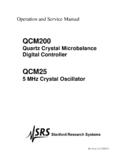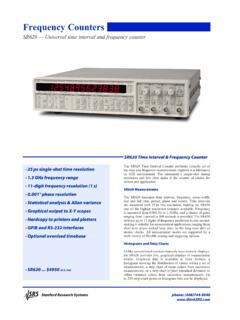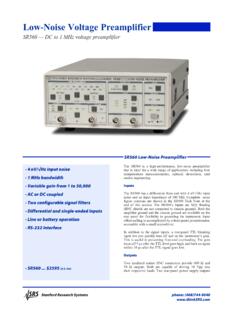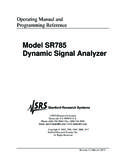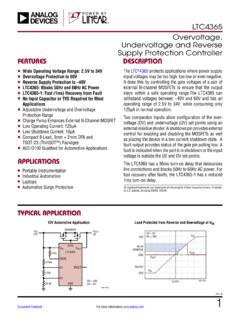Transcription of 500 kHz DSP Lock-in Amplifier
1 Operation Manual SR860. 500 kHz DSP Lock-in Amplifier Revision Certification Stanford Research Systems certifies that this product met its published specifications at the time of shipment. Warranty This Stanford Research Systems product is warranted against defects in materials and workmanship for a period of one (1) year from the date of shipment. Service For warranty service or repair, this product must be returned to a Stanford Research Systems authorized service facility. Contact Stanford Research Systems or an authorized representative before returning this product for repair. Information in this document is subject to change without notice.
2 Copyright Stanford Research Systems, Inc., 2016 2020. All rights reserved. Stanford Research Systems, Inc. 1290-C Reamwood Avenue Sunnyvale, California 94089. Printed in Document number 9-01714-903. SR860 DSP Lock-in Amplifier Safety and Preparation For Use i Safety and Preparation for Use Warning Dangerous voltages, capable of causing injury or death, are present in this instrument. Use extreme caution whenever the instrument covers are removed. Do not remove the covers while the unit is plugged into a live outlet. Line Voltage Selection Caution This instrument may be damaged if operated with the LINE VOLTAGE SELECTOR set for the wrong ac line voltage or if the wrong fuse is installed.
3 The SR860 operates from a 100V, 120V, 220V, or 240V nominal ac power source having a line frequency of 50 or 60 Hz. Before connecting the power cord, verify that the LINE. VOLTAGE SELECTOR card, located in the rear panel fuse holder, is set so that the correct ac input voltage value is indicated by the white dot. Conversion to other ac input voltages requires a change in the voltage selector card position and fuse value. See Appendix F (page 179) for detailed instructions. Line Fuse Verify that the correct line fuse is installed before connecting the line cord. For 100V/120V, use a 1 Amp fuse and for 220V/240V, use a 1/2 Amp fuse.
4 See Appendix F. (page 179) for detailed fuse installation instructions. Line Cord The SR860 has a detachable, three-wire power cord for connection to the power source and to a protective ground. The exposed metal parts of the instrument are connected to the outlet ground to protect against electrical shock. Always use an outlet which has a properly connected protective ground. Power Cord Grounding A chassis grounding lug is available on the back panel of the SR860. Connect a heavy duty ground wire, #12 AWG or larger, from the CHASSIS GROUND lug directly to a facility earth ground to provide additional protection against electrical shock.
5 Grounded BNC shields are connected to the chassis ground. Do not apply any voltage to the grounded shields. The A and B signal input shields are connected to chassis ground through resistors and can tolerate up to 1 V of applied voltage. GFCI (Ground fault Circuit Interrupter). GFCI protected outlets are often available in production and laboratory environments, particularly in proximity to water sources. GFCI's are generally regarded as an important defense against electrocution. However, the use of GFCI in conjunction with the SR860. SR860 DSP Lock-in Amplifier ii Safety and Preparation For Use must not be regarded as a substitute for proper grounding and careful system design.
6 GFCI's must also be tested regularly to verify their functionality. Always consult an electrician when in doubt. Service Do not attempt to service this instrument unless another person, capable of providing first aid or resuscitation, is present. Do not install substitute parts or perform any unauthorized modifications to this instrument. Contact the factory for instructions on how to return the instrument for authorized service and adjustment. Warning Regarding Use With Photomultipliers and Other Detectors The front end Amplifier of this instrument is easily damaged if a photomultiplier is used improperly with the Amplifier .
7 When left completely unterminated, a cable connected to a PMT can charge to several hundred volts in a relatively short time. If this cable is connected to the inputs of the SR860 the stored charge may damage the front-end Amplifier . To avoid this problem, always discharge the cable and connect the PMT output to the SR860 input before turning the PMT on. Furnished Accessories Power Cord Operating Manual Environmental Conditions Operating Temperature: +10 C to +40 C. (Specifications apply over +18 C to +28 C). Relative Humidity: <90 % Non-condensing Non-Operating Temperature: 25 C to 65 C. Humidity: <95 % Non-condensing SR860 DSP Lock-in Amplifier Safety and Preparation For Use iii SR860 DSP Lock-in Amplifier iv Safety and Preparation For Use SR860 DSP Lock-in Amplifier Contents v Contents Safety and Preparation for Use i Contents v SR860 Specifications vii SR860 Command List x SR860 Status Bytes xv Chapter 1 Getting Started 1.
8 Introduction 1. SR860 Front Panel 2. SR860 Touchscreen 4. The Basic Lock-in 9. Using Displays 13. Sensitivity, Offset and Expand 20. Saving and Recalling Setups 25. Aux Outputs and Inputs 28. Scanning 30. Chapter 2 Lock-in Amplifier Basics 37. What is a Lock-in Amplifier ? 37. What Does a Lock-in Measure? 40. Block diagram 41. The Reference Oscillator 42. The Phase Sensitive Detectors 43. Time Constants and Sensitivity 44. Outputs and Scales 46. What is Dynamic Reserve Really? 48. The Input Amplifier 50. Input Connections 51. Intrinsic (Random) Noise Sources 54. External Noise Sources 55. Noise Measurements 58. Chapter 3 Operation 61.
9 Introduction 61. Standard Settings 64. Signal Input 65. CH1 and CH2 Outputs: Offset, Ratio and Expand 71. Reference 74. Display 81. Cursor 83. SR860 DSP Lock-in Amplifier vi Contents Functions 85. Interface and Data 87. Setup 88. Rear Panel 96. Chapter 4 Programming 101. Introduction 101. Command Syntax 103. Reference Commands 106. Signal Commands 111. CH1/CH2 Output Commands 114. Aux Input and Output Commands 116. Auto Function Commands 117. Display Commands 118. Strip Chart Commands 120. FFT Screen Commands 125. Scan Commands 128. Data Transfer Commands 132. Data Capture Commands 134. Data Streaming Commands 140. System Commands 143.
10 Interface Commands 146. Status Reporting Commands 148. Status Byte Definitions 151. Appendix A Advanced Filters 155. Appendix B The FFT Display 161. Appendix C Using the Webserver 169. Appendix D Data Streaming and Capture 171. Appendix E Dual Reference Detection 175. Appendix F Fuse Installation and ac Line Select 179. Appendix G Performance Tests 183. Appendix H Circuit Description 203. SR860 DSP Lock-in Amplifier Specifications vii SR860 Specifications Signal channel Voltage Inputs Single-ended (A) or differential (A B). Sensitivity (Output Scale) 1 nV to 1 V (voltage input). 1 fA to 1 A (current input). Input Impedance 10 M +25 pF, ac (>1 Hz) or dc coupled Input Range 10 mV to 1 V (peak); max input before overload Gain Accuracy 1% below 200 kHz and 2% to 500 kHz (signal amplitude <30% of input range).
